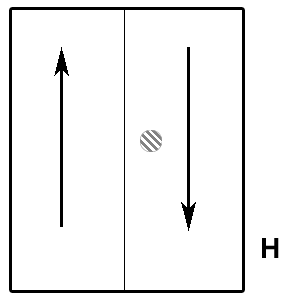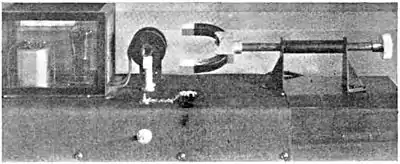巴克豪森效应
巴克豪森效应(英語:)指将铁磁材料从退磁状态加磁场磁化到饱和,在中间阶段,铁磁材料是以磁畴突然长大,不可逆和不连续位移过程实现磁化的。[1]磁畴的这种运动方式,称为巴克豪森效应。它是德国物理学家海因里希·巴克豪森于1919年发现的。

Magnetization (J) or flux density (B) curve as a function of magnetic field intensity (H) in ferromagnetic material. The inset shows Barkhausen jumps.

Origin of the Barkhausen noise: as a domain wall moves it gets caught on a defect in the crystal lattice, then "snaps" past it, creating a sudden change in the magnetic field.
巴克豪森效应说明二点:在磁化的中间阶段,铁磁材料以磁畴完成磁化;而不是以单个原子完成磁化。巴克豪森效应提供了磁畴存在的直接证据,而存在磁畴是法国物理学家皮埃爾·外斯对铁磁性解释所提出的二个基本假设之一。
參考資料
- Fukumoto,Yoshiyk,Kamijo(February 2002)"Effect of Milling Depth of the Junction Pattern on magneticproperties and yield in magnetic Tunnel Junctions" Jpn.J. Appl. Phys.41:L183-L185.
This article is issued from Wikipedia. The text is licensed under Creative Commons - Attribution - Sharealike. Additional terms may apply for the media files.
